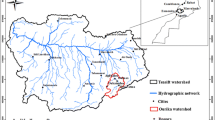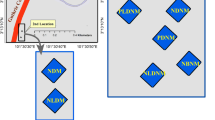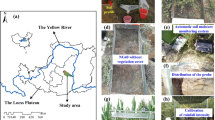Abstract
The paper presents the role of spontaneous vegetation on the hydraulic performance of an infiltration basin. The objective of the research was more particularly to study this role of different types of spontaneous vegetation found in situ in an infiltration basin near Lyon. The saturated hydraulic conductivity of three areas covered by Phalaris arundinacea, Polygonum mite, Rumex crispus and similar non-vegetated zones was compared. Eight field campaigns were carried out from July 2010 to May 2011 in order to compare the performance of each type of vegetation and its evolution over time. The results suggest a positive impact of vegetation on hydraulic performance in particular in summer during the growth of the plants. The hydraulic conductivity in this period was twice to four times higher than in bare areas or in vegetated zones during the plant rest periods. Some species were also found more appropriate to limit clogging (Phalaris arundinacea) likely due to its specific structure and growth process.





Similar content being viewed by others
References
AFNOR (1998) AFNOR P 94-047Détermination de la teneur pondérale en matières organiques d’un matériau. Méthode par calcination. (in French)
Amato M, Ladd JN (1988) Assay for microbial biomass based on ninhydrin-reactive nitrogen in extracts of fumigated soils. Soil Biol Biochem 20:107–114
Badin AL, Monier A, Volatier L, Geremia RA, Delolme C, Bedell J-P (2011) Structural stability, microbial biomass and community composition of sediments affected by the hydric dynamics of an urban stormwater infiltration basin. Microb Ecol 61:885–897
Baveye P, Vadevivere P, Hoyle BL, Deleo PC, de lozada DS (1998) Environmental impact and mechanisms of the biological clogging of saturated soils and aquifer materials. Crit Rev Environ Sci Technol 28(2):123–191
Bedell J-P, Mourier B, Provot J, Winiarski T (2013) Influences on the establishment and dominance of vegetation in stormwater infiltration basins. Water Sci Technol. doi:10.2166/wst.2013.526
Braud I, De Condappa D, Soria JM, Haverkamp R, Angulo-jaramillo R, Galle S, Vauclin M (2005) Use of scaled forms of the infiltration equation for the estimation of unsaturated soil hydraulic properties (the Beerkan method). Eur J Soil Sci 56:361–374
Cerda A (1996) Seasonal variability of infiltration rates under contrasting slope conditions in southeast Spain. Geoderma 69:217–232
Cerda A (1997) Seasonal changes of the infiltration rates in a Mediterranean scrubland on limestone. J Hydrol 198:209–225
Ellis JB (2000) Infiltration systems: a sustainable source-control option for urban stormwater quality management. Water Environ J 14(1):27–34
Emerson C, Traver RG (2008) Multiyear and seasonal variation of stormwater best management practices. J Irrig Drain Eng 134(5):598–605
Emerson C, Wadzuk B, Traver R (2010) Longevity and total suspended solids capture efficiency of an aged infiltration trench. Hydrol Process 24:1008–1014
Geldof G, Lacobsen P, Fujita S (1994) Urban stormwater infiltration perspectives. Water Sci Technol 29(1–2):245–254
Gilbert-Jenkins J-K, Wadzuk B-M, Welker A-L (2010) Fines accumulation and distribution in a storm-water rain garden nine years post-construction. J Irrig Drain Eng 136(12):862–869
Gonzalez-Merchan C (2012) Knowledge improvements about clogging in stormwater infiltration systems). PhD thesis, INSA Lyon, France, 298 p. (in French)
Gonzalez-Merchan C. and Barraud S. (2011a). Spatio-temporal evolution of clogging of stormwater infiltration systems. 12th International Conference on Urban Drainage, Porto Alegre/Brazil, 10–15 September 2011, 8 p in [CD-ROM]
Gonzalez-Merchan C, Barraud S (2011) Characterization and main factors affecting clogging evolution of stormwater infiltration systems. 12th International Conference on Urban Drainage, Porto Alegre/Brazil, 10–15 September 2011, 8 p in [CD-ROM]
Gonzalez-Merchan C, Barraud S, Le Coustumer S, Fletcher T (2012) Monitoring of clogging evolution in the stormwater infiltration system and determinant factors. Eur J Environ Civil Eng 16(1):34–47
Hatt BE, Fletcher TD, Deletic A (2009) Hydrologic and pollutant removal performance of biofiltration systems at the field scale. J Hydrol 365(3–4):310–321
ISO 13320 (2009) Particle size analysis, Laser diffraction methods
ISO/IEC Guide 98-3 (2008) Suppl 1:2008 Propagation of distributions using a Monte Carlo method.Jaynes DB (1990) Temperature variation effect on field-measured infiltration. Soil Sci Soc Am J 54(2):305–312
Joergensen RG, Mueller T (1996) The fumigation-extraction method to estimate soil microbial biomass: calibration of the k EN value. Soil Biol Biochem 28:33–37
Lassabatere L, Angulo-Jaramillo R, Soria Ugalde JM, Cuenca R, Braud I, Haverkamp R (2006) Beerkan estimation of soil transfer parameters through infiltration experiments. Soil Sci Soc Am J 70:521–532
Le Coustumer S, Barraud S (2007) Long-term hydraulic and pollution retention performance of infiltration systems. Water Sci Technol 55(4):235–243
Le Coustumer S, Fletcher TD, Deletic A, Barraud S, Lewis JF (2009) Hydraulic performance of biofilter systems for stormwater management: influences of design and operation. J Hydrol 376(1–2):16–23
Lerner DN, Issar AS, Simmers I (1990) Groundwater Recharge. Intl Assoc, Hydrogeologists, 345 p
Li HW, Sharkey LJ, Hunt WF, Davis AP (2009) Mitigation of impervious surface hydrology using bioretention in North Carolina and Maryland. J Hydrol Eng 14(4):407–415
Marsalek J, Chocat B (2002) International report: stormwater management. Water Sci Technol 46(6–7):1–17
Meyer S, Reeb C, Bosdeveix R (2008) Botanique Biologie et physiologie végétales. Maloine 2eme édition. 490p. (in French)
Nogaro G, Mermillod-Blondin F (2009) Stormwater sediment and bioturbation influences on hydraulic functioning, biogeochemical processes, and pollutant dynamics in laboratory infiltration systems. Environ Sci Technol 43:3632–3638
Pichan SP, Okelly BC (2012) Stimulated decomposition in peat for engineering applications. Proc ICE - Ground Improv 166(2):168–176
Saulais M (2011) Vegetation of stormwater basins: flora inventory and physico-chemical characterization of vegetated surface. PhD thesis, Industrial and Urban Environment Sciences, INSA Lyon, France. 245 p. (in French)
Saulais M, Bedell JP, Delolme C (2011) Cd, Cu and Zn mobility in contaminated sediments from an infiltration basin colonized by wild plants: the case of Phalaris arundinacea and Typha latifolia. Water Sci Technol 64(1):255–262
USDA (1975) Soil Taxonomy A Basic System for Making and Interpreting Soil Surveys. Govt. Printing office, Washington DC
Virahsawmy H, Stewardson M, Vietz G, Fletcher TD (2013) Factors that affect the hydraulic performance of raingardens: implications for design and maintenance. 8th international conference on sustainable techniques and strategies in urban water management, Novatech 2013, Lyon, France
Walsh C J, Leonard A W, Ladson A R, and Fletcher T D (2004) Urban stormwater and the ecology of streams. Cooperative Research Centre for Freshwater Ecology and Cooperative Research Centre for Catchment Hydrology, Canberra
Wenger SJ, Roy AH, Jackson CR, Bernhardt ES, Carter TL, Filoso S, Gibson CA, Hession CW, Kaushal SS, Martí E, Meyer JL, Palmer MA, Paul MJ, Purcell AH, Ramírez A, Rosemond AD, Schofield KA, Sudduth EB, Walsh CJ (2009) Twenty-six key research questions in urban stream ecology: an assessment of the state of the science. J N Am Benthol Soc 28:1080–1098
Acknowledgments
The authors thank the “Région Rhône Alpes” for the PhD scholarship, OTHU (Field Observatory in Urban Hydrology) for scientific support and the Greater Lyon Community. We are particularly grateful to Cécile Delolme, Rafaël Angulo and Tim Fletcher for their collaboration.
Author information
Authors and Affiliations
Corresponding author
Additional information
Responsible editor: Philippe Garrigues
Rights and permissions
About this article
Cite this article
Gonzalez-Merchan, C., Barraud, S. & Bedell, JP. Influence of spontaneous vegetation in stormwater infiltration system clogging. Environ Sci Pollut Res 21, 5419–5426 (2014). https://doi.org/10.1007/s11356-013-2398-y
Received:
Accepted:
Published:
Issue Date:
DOI: https://doi.org/10.1007/s11356-013-2398-y




